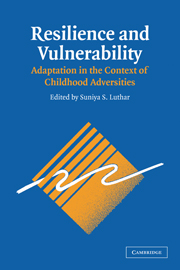Book contents
- Frontmatter
- Contents
- List of Contributors
- Foreword by Dante Cicchetti
- Preface
- 1 A Resilience Framework for Research, Policy, and Practice
- PART I FAMILIAL ADVERSITIES: PARENTAL PSYCHOPATHOLOGY AND FAMILY PROCESSES
- PART II EXOSYSTEMIC AND SOCIODEMOGRAPHIC RISKS
- 10 Rethinking Resilience: A Developmental Process Perspective
- 11 Poverty and Early Childhood Adjustment
- 12 Emerging Perspectives on Context Specificity of Children's Adaptation and Resilience: Evidence from a Decade of Research with Urban Children in Adversity
- 13 Holistic Contextual Perspectives on Risk, Protection, and Competence among Low-Income Urban Adolescents
- 14 Overcoming the Odds? Adolescent Development in the Context of Urban Poverty
- 15 Adaptation among Youth Facing Multiple Risks: Prospective Research Findings
- 16 Positive Adaptation among Youth Exposed to Community Violence
- 17 Perceived Discrimination and Resilience
- 18 Promoting Resilience through Early Childhood Intervention
- PART III COMMENTARIES
- Index
- References
15 - Adaptation among Youth Facing Multiple Risks: Prospective Research Findings
Published online by Cambridge University Press: 05 June 2012
- Frontmatter
- Contents
- List of Contributors
- Foreword by Dante Cicchetti
- Preface
- 1 A Resilience Framework for Research, Policy, and Practice
- PART I FAMILIAL ADVERSITIES: PARENTAL PSYCHOPATHOLOGY AND FAMILY PROCESSES
- PART II EXOSYSTEMIC AND SOCIODEMOGRAPHIC RISKS
- 10 Rethinking Resilience: A Developmental Process Perspective
- 11 Poverty and Early Childhood Adjustment
- 12 Emerging Perspectives on Context Specificity of Children's Adaptation and Resilience: Evidence from a Decade of Research with Urban Children in Adversity
- 13 Holistic Contextual Perspectives on Risk, Protection, and Competence among Low-Income Urban Adolescents
- 14 Overcoming the Odds? Adolescent Development in the Context of Urban Poverty
- 15 Adaptation among Youth Facing Multiple Risks: Prospective Research Findings
- 16 Positive Adaptation among Youth Exposed to Community Violence
- 17 Perceived Discrimination and Resilience
- 18 Promoting Resilience through Early Childhood Intervention
- PART III COMMENTARIES
- Index
- References
Summary
The high prevalence of mental health problems among children in the United States has continued to stimulate service-oriented professionals to seek targets for preventive intervention. In a 1999 survey of youth risk behavior during the previous year (Centers for Disease Control and Prevention, 2000), 28% of high school children felt blue or hopeless, 19% had considered suicide, and 8% had made an attempt. In terms of aggression, 36% had been in a physical fight. Academic problems were equally serious, with 30% of Hispanics dropping out before high school graduation compared to 14% of African Americans and 8% of whites. Although the majority of youth do not have such problems, the number who do is substantial.
Understanding the pathways that have led to such problem behavior is an important precursor of any successful intervention. Prevention is intimately connected to developmental concerns because there is an expected time course in which activities in the present will influence activities in the future. Where the problem seems to be in the family, school, or peer group, intuitively interventions should take place in those settings and should have immediate impact. Unfortunately, most interventions in single domains have not produced major reductions in problem behavior. It appears that children typically experience multiple risks in multiple social contexts; consequently, it is unlikely that a “magic bullet” for prevention or intervention will be found (Masten & Coatsworth, 1998).
- Type
- Chapter
- Information
- Resilience and VulnerabilityAdaptation in the Context of Childhood Adversities, pp. 364 - 391Publisher: Cambridge University PressPrint publication year: 2003
References
- 123
- Cited by



